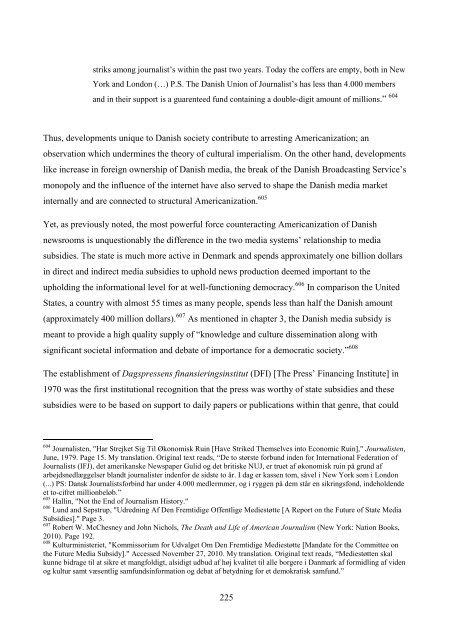The Jeremiad Over Journalism
The Jeremiad Over Journalism
The Jeremiad Over Journalism
Create successful ePaper yourself
Turn your PDF publications into a flip-book with our unique Google optimized e-Paper software.
striks among journalist‘s within the past two years. Today the coffers are empty, both in New<br />
York and London (…) P.S. <strong>The</strong> Danish Union of Journalist‘s has less than 4.000 members<br />
and in their support is a guarenteed fund containing a double-digit amount of millions.‖ 604<br />
Thus, developments unique to Danish society contribute to arresting Americanization; an<br />
observation which undermines the theory of cultural imperialism. On the other hand, developments<br />
like increase in foreign ownership of Danish media, the break of the Danish Broadcasting Service‘s<br />
monopoly and the influence of the internet have also served to shape the Danish media market<br />
internally and are connected to structural Americanization. 605<br />
Yet, as previously noted, the most powerful force counteracting Americanization of Danish<br />
newsrooms is unquestionably the difference in the two media systems‘ relationship to media<br />
subsidies. <strong>The</strong> state is much more active in Denmark and spends approximately one billion dollars<br />
in direct and indirect media subsidies to uphold news production deemed important to the<br />
upholding the informational level for at well-functioning democracy. 606 In comparison the United<br />
States, a country with almost 55 times as many people, spends less than half the Danish amount<br />
(approximately 400 million dollars). 607 As mentioned in chapter 3, the Danish media subsidy is<br />
meant to provide a high quality supply of ―knowledge and culture dissemination along with<br />
significant societal information and debate of importance for a democratic society.‖ 608<br />
<strong>The</strong> establishment of Dagspressens finansieringsinstitut (DFI) [<strong>The</strong> Press‘ Financing Institute] in<br />
1970 was the first institutional recognition that the press was worthy of state subsidies and these<br />
subsidies were to be based on support to daily papers or publications within that genre, that could<br />
604 Journalisten, "Har Strejket Sig Til Økonomisk Ruin [Have Striked <strong>The</strong>mselves into Economic Ruin]," Journalisten,<br />
June, 1979. Page 15. My translation. Original text reads, ―De to største forbund inden for International Federation of<br />
Journalists (IFJ), det amerikanske Newspaper Gulid og det britiske NUJ, er truet af økonomisk ruin på grund af<br />
arbejdsnedlæggelser blandt journalister indenfor de sidste to år. I dag er kassen tom, såvel i New York som i London<br />
(...) PS: Dansk Journalistsforbind har under 4.000 medlermmer, og i ryggen på dem står en sikringsfond, indeholdende<br />
et to-cifret millionbeløb.‖<br />
605 Hallin, "Not the End of <strong>Journalism</strong> History."<br />
606 Lund and Sepstrup, "Udredning Af Den Fremtidige Offentlige Mediestøtte [A Report on the Future of State Media<br />
Subsidies]." Page 3.<br />
607 Robert W. McChesney and John Nichols, <strong>The</strong> Death and Life of American <strong>Journalism</strong> (New York: Nation Books,<br />
2010). Page 192.<br />
608 Kulturministeriet, "Kommissorium for Udvalget Om Den Fremtidige Mediestøtte [Mandate for the Committee on<br />
the Future Media Subsidy]." Accessed November 27, 2010. My translation. Original text reads, ―Mediestøtten skal<br />
kunne bidrage til at sikre et mangfoldigt, alsidigt udbud af høj kvalitet til alle borgere i Danmark af formidling af viden<br />
og kultur samt væsentlig samfundsinformation og debat af betydning for et demokratisk samfund.‖<br />
225
















